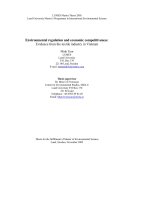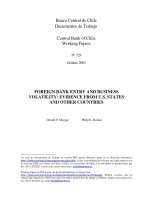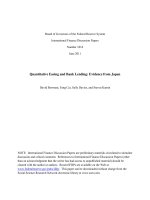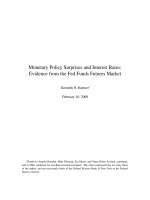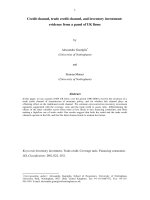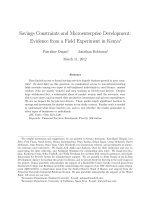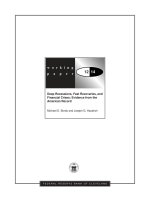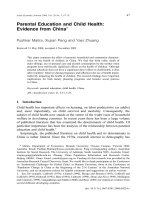LEGAL SYSTEM AND TRADE CREDIT EVIDENCE FROM INTERNATIONAL DATA
Bạn đang xem bản rút gọn của tài liệu. Xem và tải ngay bản đầy đủ của tài liệu tại đây (348.05 KB, 65 trang )
LEGAL SYSTEM AND TRADE CREDIT: EVIDENCE FROM INTERNATIONAL
DATA
LIM I-MIN PEARL
B.Soc.Sci.(Hons.), NUS
A THESIS SUBMITTED FOR THE DEGREE OF MASTER OF SOCIAL
SCIENCES (RESEARCH)
DEPARTMENT OF ECONOMICS
NATIONAL UNIVERSITY OF SINGAPORE
2012
Acknowledgements
I would like to thank my supervisor, Dr Lu Yi, for his patient guidance and kind
understanding throughout. I would also like to thank anyone else who supported me,
in one way or another, during the course of my studies.
i
Table of Contents
Acknowledgements
i
Summary
iii
List of Tables
iv
1. Introduction
1
2. Data and Variables
8
2.1 Data
8
2.2 Trade Credit
10
2.3 Legal System
12
2.4 Instruments
14
2.5 Control Variables
15
3. Empirical Analysis
18
3.1 Empirical Strategy
18
3.2 Tobit and OLS Results
23
3.3 GMM Results
24
3.4 Robustness Checks
26
4. Conclusion
29
Bibliography
30
Appendix 1. Variables Definitions and Sources
35
Appendix 2. Tables
39
ii
Summary
Using a World Bank large-scale, firm-level dataset for 47,346 firms in 69 emerging
economies for the period of 2002-2006, I empirically investigate the impact of the
efficiency of a country's legal system on firms' provision of trade credit. I find a
positive and significant effect. The result is robust to a set of conventional controls
used in the literature and to alternative measures of trade credit and legal system,
including a Property Rights Index from The Heritage Foundation. To solve for the
potential endogeneity of legal system I utilise the two-step Generalized Method of
Moments (GMM) method and stepwisely include seven control variables. The
instrument used for the full sample is legal origin; whereas for the sub-sample of 33
ex-colonies, I alternatively use three instruments: the settler mortality rates of
Europeans in colonies during 1600s to 1800s, the population density of the colonies
in 1500 and urbanisation in 1500. Meanwhile, I find that legal system has a larger
impact on trade credit for firms in more-developed countries or with overdraft
facilities.
iii
List of Tables
Table 1a: Data Description
39
Table 1b: Instruments Data Description for Ex-colonies
43
Table 2: Summary Statistics
45
Table 3: Patterns of Trade Credit and Legal System
46
Table 4: Tobit and OLS Results
47
Table 5a: GMM Estimates for Full Sample with Legal Origin as Instrument
48
Table 5b: GMM Estimates for Ex-Colonies with Settler Mortality as Instrument
50
Table 5c: GMM Estimates for Ex-Colonies with Population Density in 1500 as
Instrument
52
Table 5d: GMM Estimates for Ex-Colonies with Urbanisation in 1500 as
Instrument
54
Table 6: Alternative Measure of Trade Credit and Legal System for Full Sample
56
Table 7: Firms with Different Borrowing Facilities
57
Table 8: Firms in Countries with Different Development Levels
58
Table 9: GMM Estimates with Property Rights as the Dependent Variable
59
iv
1. INTRODUCTION
Trade credit or account receivables have been shown to be an important source of
financing in both developing and developed economies. In an empirical study on the
G-7 countries, Rajan and Zingales (1995) found that trade credit makes up 17.8% of
total assets for all American firms in 1991, whereas for Japan, Germany, France, Italy
and United Kingdom figures range from 22.1% to 29%. For emerging countries,
studies have also suggested likewise. For example, McMillan and Woodruff (1999)
reported an average of 30% of the bills not paid after the suppliers had delivered the
goods in Vietnam; while Cull, Xu and Zhu (2009) found that trade credit ranged from
21.5% to 27.2% of total sales in China for the period of 1998-2003. Focusing on
manufacturing firms in six African countries, Bigsten et al. (2003) report that trade
credit was received by 62% of the sampled firms between 1992 to 1996 and is the key
source for financing working capital. Other studies on African firms, similarly,
underscore the importance of trade credit. In the 1994 RPED 1 report of Fafchamps et
al. on the Kenyan manufacturing industry and the 1995 report on Zimbabwean firms,
both reveal that trade credit plays a crucial role in financing. A newer study by Shvets
(2012), on 11,000 Russian firms between 1996 and 2002, shows that most of the
firms have trade credit financing compared to only 40% for bank loans, and the
average magnitude for the former exceeds the latter.
More recently, the role of trade credit in financial crises is also examined. While
there have been only a few studies on this topic up to date, nevertheless preliminary
evidence points to a substitution effect between trade credit and bank credit. For
example, Bastos and Pindado (2012) used a dataset of 147 firms from Argentina,
Brazil and Turkey in 1999 to 2003; and found that trade credit increases for a short
1
Regional Program on Enterprise Development
1
period following a financial crisis. Love, Preve and Sarria-Allende (2007) in their
study on 890 firms in six emerging economies; and Preve (2004) in his study on 530
firms in six countries, too, documented a similar trend. Thus, trade credit has a shortterm offsetting effect on credit tightening by formal financial institutions.
The prevalence and importance of trade credit spurred many theories to explain
why firms want to grant it. One of the earliest papers to attempt this is Schwartz's
(1974) study, which posits a financing motive. Credit providers with easy access to
formal sources of financing have an incentive to provide credit when credit receivers
increase their purchase of factors of production in response. Similarly, Emery (1984)
argues that financial market imperfections prompt firms to lend out liquid reserves in
the form of trade credit so as to earn a higher than market lending rate of returns.
Concerning transition countries, Delannay and Weill (2004) analysed a dataset
consisting of 9300 companies from nine Central and Eastern European Countries in
1999 and 2000, and conducted regressions by country to investigate the importance
of commercial motive and financial motive for trade credit. They found financial
motive to be a key factor, that is "suppliers act as financial intermediaries in favour of
firms with a limited access to bank credit" (page 191).
Besides financial motives, a number of other determinants have also been identified
including transaction uncertainty [e.g. Ferris (1981)], market power and price
discrimination [e.g. Schwartz and Whitcomb (1979); Brennan, Maksimoviz and
Zechner (1988); Ng, Smith and Smith (1999)], scale economy and seniority [e.g.
Petersen and Rajan (1997)], ownership structure [e.g. Cull, Xu and Zhu (2009)],
market structure [e.g. Fisman and Raturi (2004), Hyndman and Serio (2010)],
relations between the trading partners [e.g. Biais and Gollier (1997), McMillan and
Woodruff (1999), Burkart and Ellingsen (2004), Cuñat (2007)], externalities and
2
trade-offs between suppliers and downstream firms in the transfer of inventory [e.g.
Bougheas, Mateut and Mizen (2009); Daripa and Nilsen (2011)] and specialised
goods by suppliers [e.g. Giannetti, Burkart and Ellingsen (2011); Mateut, Mizen and
Ziane (2012)], among others.
Other works emphasise the effect of legal systems or the development level of
financial markets. Fisman and Love (2003) reported that "industries that are more
dependent on trade credit financing grow relatively more rapidly in countries with
less developed financial intermediaries" (page 373). Whereas Demirgüç-Kunt and
Maksimovic (2001) in their unpublished empirical study ran both a multivariate
regression and a two-stage regression - that instrument for the size of the banking
system - on large publicly-traded manufacturing firms in 40 developing and
developed countries for the period 1989-1996, and found that firms in countries with
efficient legal systems and/or with a common law origin offer less trade credit.
Conversely, trade credit usage increases with the size of the banking system, and this
result is more pronounced when the banks have a low proportion of state ownership.
In a similar vein, studies that have examined the relation between legal systems and
trade credit found mixed results. In a 1999 study, McMillan and Woodruff surveyed
259 privatised, manufacturing firms in Vietnam in 1995-1997, and found that 91% of
the firms said courts could not enforce a contract 2 . Instead, they show that a lack of
alternative suppliers is a strong, positive determinant of trade credit lending. More
lately, Shvets (2012) employs a fixed-effects ordinary least squares regression (OLS)
on Russian firms, with the appeal rate of a court as an inverse indicator for its quality,
but cannot find a statistically significant effect of court quality on trade credit.
2
Nevertheless, the authors did not prove if the efficiency of courts could promote or discourage trade
credit. Presumably, because the legal system in Vietnam was so undeveloped, that virtually no firms
used them in business disputes.
3
In contrast, Hendley, Murrell and Ryterman (2000) conducted a survey on 328
Russian firms between May and August 1997 to investigate the methods used by
firms in enforcing business agreements with their trading partners, and they
concluded that actual or threatened use of courts is the most widely-used method after
direct negotiations fail.
In addition, Kaniki (2006) examines the relationship between trade credit and legal
system in East Africa. Using data for 282 Kenyan, 300 Ugandan and 276 Tanzanian
manufacturing firms between 2002 and 2003, the author investigates three hypotheses,
including if "courts are important for resolving disputes over trade credit payments"
(page 6) and if "trade credit supply increases with the efficiency of the court system"
(page 8). Kaniki ran regressions to determine these hypotheses, notwithstanding the
possibilities of reverse causality, he concluded that efficient courts are an effective
deterrents to overdue trade credit payments because they make for credible threats.
Furthermore, trade credit supply increases when enforcement costs are low and courts
are efficient.
Arriving at similar conclusions on the importance of courts is Johnson, McMillan
and Woodruff in their 2002a paper. Surveys were conducted in 1997, on 300
privately-owned manufacturing firms in each of five post-communist countries:
Russia, Ukraine, Poland, Romania and Slovakia. The authors, then, used the data for
1460 firms, and performed Probit and Tobit regressions to determine the effect of
three sets of variables (i.e. bilateral relational contracting; trade association, business
networks and social networks; and courts) on trade credit. They found that belief in
the effectiveness of courts have a strong positive association with the provision of
trade credit, especially for new relationships, and when there is low search cost in
finding alternative suppliers (i.e. lock-in is low). It also encourages the establishment
4
of new business partnership, which otherwise would not have taken place,
particularly for specialised goods. Whereas relational contracting, like relationship
duration and the use of networks, supports trade credit considerably in existing
relationships and when lock-in is high.
Apart from the aforementioned papers, to the best of my knowledge, no other
papers have studied the relationship between property rights and trade credit. Thus, I
attempt to augment the literature by using an instrumental variable (IV) approach,
which none of the previous studies have done.
The provision of trade credit involves an implicit contract between the credit
provider and the credit receiver, in which the former agrees to allow the latter to
acquire the goods first and pay later. Thus, according to Johnson, McMillan and
Woodruff (2002a), there are two roles for legal system in trade credit supply. First,
legal system helps to ensure the credit receiver pays for the goods eventually. A more
complex role is "to ensure the goods delivered are of adequate quality and in allowing
specific investment to be undertaken" (page 224). More specifically, it has been
argued that legal system could promote trade credit through the a) contents of the law
which define the legal rights of creditors, and b) effectiveness in which these rights
are enforced through the courts 3 .
The next point of interest is why actual or perceived effectiveness of legal system
increases trade credit. In the study by Kaniki (2006), he found that better quality of
courts and lower cost of enforcement could prevent opportunistic behaviour by the
receiver. This, I believe, could increase the confidence of the credit provider,
resulting in higher credit supply. Johnson, McMillan and Woodruff (2002a) also
found that greater firms' belief in courts lead to the granting of more trade credit.
3
In my study, the survey data renders that I can only investigate the impact of b) on trade credit.
5
Furthermore, they argued that effective courts lowers barriers to entry for new
suppliers. Firms that express greater judiciary confidence are 7% less likely to reject a
new supplier who offers trade credit, presumably this could result in more trade credit
if the incumbent supplier is not abandoned.
Hence, the aim of my study is to empirically substantiate the hypothesis that
effective legal system increases trade credit. Using the dataset of The World Bank
Enterprise Surveys, the empirical strategy I follow estimate my model by ordinary
least squares (OLS) and Tobit while controlling for firm heterogeneity by adding
firm-specific characteristics and industry dummies. To address the possible
endogeneity issues (i.e., omitted variables bias, reverse causality and measurement
error), I use the instrumental variable (IV) approach, and stepwisely include seven
control variables . For my IV estimator, Generalised Method of Moments (GMM), I
use as instrument legal origin for the efficiency of legal system. In addition, for the
subset of ex-colonies in my sample I follow Acemoglu, Johnson and Robinson (2001,
2002), and use European settler mortality rates in 1600s to 1800s, urbanisation in
1500 and population density in 1500 as instruments.
In my robustness checks, I use alternative measures of the dependent and
independent variables for the Tobit regressions. Specifically, I alternatively use firms'
perception of legal services and the Property Rights Index from The Heritage
Foundation as indicators of the efficiency of legal system, and the ratio of accounts
receivable over total sales as a proxy for trade credit. In addition, I investigate the
impact of legal efficiency on trade credit for firms with different borrowing facilities
and located at countries with different development level. Lastly, I replicate the
GMM estimations for my baseline specifications with Property Rights Index.
6
I find positive and significant associations between the efficiency of legal system
and trade credit for the OLS and Tobit regressions. For the GMM estimation with
legal origin as the instrument, in the first stage, consistent with the literature, I find
that legal system is more efficient in enforcing contractual and property rights in
business disputes in countries with a common law system than in countries with a
civil law system. When settler mortality rates, urbanisation in 1500 and population
density in 1500 are alternatively used as the instruments, in accordance with the
findings of Acemoglu, Johnson and Robinson (2001, 2002), I find a negative relation
between these variables and the legal system. In the second stage, all my GMM
results also reveal a positive and significant impact of legal system on trade credit.
These outcomes are robust to the seven additional controls included stepwisely and
when I use a different proxy for legal system, that is Property Rights Index. Finally, I
find that legal system has a larger impact on trade credit for firms in more-developed
countries or with overdraft facilities.
The remainder of the paper is structured as follows. Section 2 introduces the data
and variables for the empirical study, while Section 3 presents the estimation strategy
and the empirical results. The paper is concluded in Section 4.
.
7
2. Data and Variables
2.1 Data
Following earlier surveys on establishment business climate, the Enterprise Analysis
Unit of the World Bank started in 2002 a large-scale project called "The World Bank
Enterprise Surveys" (WBESs), with the objective to provide the world's most
comprehensive firm-level data in emerging economies. The WBESs are carried out in
cooperation with local business organizations and government agencies, and they are
performed approximately every three years for most countries with different countries
surveyed at different times. The WBESs include industries from the manufacturing
sector, service sector, and other sectors such as agriculture and construction, and they
survey private firms using either a simple random or random stratified sampling
methodology.
The dataset I use in this paper is called Private Enterprise Survey of Productivity
and the Investment Climate (PESPIC). It is a standardised dataset based on a series of
WBESs conducted in individual countries for the period of 2002-2006. It was
compiled by the World Bank as a way to provide researchers with a comparable
cross-country, firm-level dataset. As the WBESs use different questionnaire designs
and survey methodologies in different countries and different times not all the
variables are available in certain countries or in certain periods. Meanwhile,
compromises are made by the World Bank in order to match some of the variables
during the standardisation.
The PESPIC is a cross-section of data with limited time series aspects and is
composed of two parts. One is a general questionnaire directed at the senior
management seeking information about the firm, sales and suppliers, investment
climate constraints, infrastructure and services, finance, business-government
8
relations, conflict resolution and legal environment, crime, capacity and innovation,
and labour relations. The other questionnaire is directed at the accountant manager,
and it covers various financial measures such as production, sales, expenses, total
assets and total liabilities.
The dataset includes a total of 47,346 firms from 69 emerging economies,
such as China, India and Russia, among others. It contains 30,238 firms from 16
manufacturing industries (Textiles, Leather, Garments, Food, Beverages, Metals and
Machinery, Electronics, Chemicals and Pharmaceuticals, Construction Equipment,
Wood and Furniture, Non-Metallic and Plastic Materials, Paper, Sport Goods, Auto
and Auto-Components, Other Transport Equipment and Other Manufacturing),
13,750 firms from 9 service industries (IT Services, Telecommunications,
Accounting and Finance, Advertising and Marketing, Retail and Wholesale Trade,
Hotels and Restaurants, Transport, Real Estate and Rental Services and Other
Services), 711 firms from the agriculture sector, 2,327 firms from the construction
sector and 320 firms from other sectors.
I also use the Index of Economic Freedom, an annual survey that began in 1995,
from The Heritage Foundation. Consisting of ten benchmarks, from business freedom
to labour freedom, it offers a comprehensive measure of economic success for 184
countries. For my purpose, I only utilise one benchmark, the Property Rights Index,
as an alternative measure of the independent variable.
For the instruments used in this paper, I obtained the data from two different
sources. I use data for legal origins from La Porta, Lopez-de-Silanes and Shleifer
(2008). While the data for Settler Mortality, Population Density in 1500 and
Urbanisation in 1500 are taken from Acemoglu, Johnson and Robinson (2002). To
identify which countries are ex-colonies, I use the Ex-colony dummy variable from
9
Acemoglu, Johnson and Robinson (2002), where countries that are formerly colonies
take a value of one. I have 22,621 firms in the 33 former colonies in my sample.
Table 1a presents the surveyed countries, their legal origins, the survey year and
the corresponding number of surveyed firms, as well as the mean values of the
dependent and independent variables. In addition, I identify which of the countries
are ex-colonies and show the values of the instruments used. Appendix 2 gives
detailed definitions and sources for the variables used in this study. In the following
sub-sections, I will discuss Trade Credit, Legal System, the instruments and the
control variables.
2.2 Trade Credit
The dependent variable of my analysis is the extent of trade credit, which is measured
in two ways.
First, the PESPIC includes the following question to the senior management "What
percentage of your establishment's sales is sold on credit, i.e., full payment is not due
at the time of delivery?" I divide all the answers by 100, so that my dependent
variable, Trade Credit, will range from 0 to1.
Second, I use the ratio of accounts receivable over total sales, and denote it as
Accounts Receivable Ratio. This is the most commonly-used measure of trade credit
in the literature [Brennan, Maksimoviz and Zechner (1988); Petersen and Rajan
(1997); and Ng, Smith and Smith (1999)]. Unfortunately, as information about
accounts receivable is fragmentary (only available for 13,915 firms in 28 countries or
30% of the total number of firms in this survey), I use Accounts Receivable Ratio as
a robustness check and Trade Credit for the main analysis.
10
Table 2 reports the summary statistics of the data. Referring to Table 2, the mean
value of Trade Credit is 0.450 ( 0.401) and that of Accounts Receivable Ratio is
0.140 ( 0.163).
Column 3 of Table 1a and Column 1 of Table 3 further present the patterns of
Trade Credit across various categories. Referring to Column 3 of Table 1a, the top
five countries with the highest values of Trade Credit are Malaysia in 2002 (with a
mean value of 0.813), Brazil in 2003 (with a mean value of 0.791), Morocco in 2004
(with a mean value of 0.744), South Africa in 2003 (with a mean value of 0.742), and
Thailand in 2004 (with a mean value of 0.692). On the other hand, the top five
countries with the lowest values of Trade Credit are Uzbekistan in 2003 (with a mean
value of 0.027), Tajikistan in 2003 (with a mean value of 0.049), Uzbekistan in 2005
(with a mean value of 0.065), Slovenia in 2002 (with a mean value of 0.078) and
Croatia in 2002 (with a mean value of 0.096). None of the bottom five countries have
a common law origin, while three 4 of the top five have.
From Column 1 of Table 3, countries with a common law system have on average a
higher mean value of Trade Credit (0.576) than those with a civil law system (0.408).
Across different sectors, the manufacturing sector is found to have the highest mean
value of Trade Credit (0.531), followed by other sectors (0.411), the agriculture
sector (0.409), the construction sector (0.348) and lastly the service sector (0.266).
Comparing firms with different borrowing facilities, I find that firms with overdraft
facilities tend to provide more trade credit (with a mean value of 0.625) than those
without overdraft facilities (with a mean value of 0.455). I also find that firms located
in more-developed countries [defined as Gross National Income (GNI) per capita
above the sample median of US$2120] have a higher mean value of Trade Credit
4
The three countries that have a common law origin are Malaysia, South Africa and Thailand.
11
(0.502) than those located in less-developed countries (0.382). Finally, I observe that
firms in countries that are ex-colonies have a higher mean value of Trade Credit
(0.555) compared with those that are not in former colonies (0.363). This can be
attributed to the larger percentage of countries with a common law origin among excolonies in my sample. Specifically, 14 of the 16 common law origin countries are
ex-colonies.
Together, these descriptive results suggest a relationship between Trade Credit and
the family of legal system. Furthermore the data also shows that Trade Credit can
vary across firms according to the firm's industry, country location and borrowing
facilities.
2.3 Legal System
The key explanatory variable of this study is the efficiency of legal system.
Following the approach of the recent literature on economic institutions [e.g.,
Johnson, McMillan and Woodruff (2002b); Cull and Xu (2005)] , I use the subjective
measure perceived by the firm. Specifically, the PESPIC has the following question 5
to senior management: "To what degree do you agree with this statement 'I am
confident that the judicial system will enforce my contractual and property rights in
business disputes'?" There are six possible answers: (1) fully agree, (2) disagree in
most cases, (3) tend to disagree, (4) tend to agree, (5) agree in most cases and (6)
fully agree. Accordingly, I construct the variable - Legal System - with the responses
varying from 1 to 6 with a higher value indicating a more efficient legal system. From
Table 2, Legal System has a mean value of 3.676 and a standard deviation of 1.475.
5
Ayyagari, Demirguc-Kunt and Maksimovic (2008); Yasar, Paul and Ward (2011); and Kaniki (2006)
also used the same survey question to measure property rights. The first paper explores the link
between property rights and independent variables (used in influential institutional theories) within an
ANOVA framework. The second paper uses a two-stage-least-squares approach, namely GMM
estimation, to determine the impact of property rights on firms' productivity and profitability. While
the third paper had been discussed in the Introduction.
12
In robustness checks of the measure of legal system, I use Legal Service as an
alternative measure because it is only available for 8,113 firms in 20 countries . It is
based on the senior management's reply to the question "For legal services, for your
establishment over the last year, please ...... evaluate the quality on a 1-4 scale where
1 is very poor and 4 is very good". In Table 2, Legal Service has a mean value of
2.879 and a standard deviation of 0.808.
In addition, I use the Property Rights Index from The Heritage Foundation as
another alternative measure of the efficiency of legal system. The index, as a broad
measure, is based on the level of protectiveness of the country's property rights laws,
effectiveness of enforcement, likelihood of expropriation, independence of and
existence of corruption within the judiciary and enforceability of contracts by
individuals and firms. It is measured from 10 to 100 with a higher value indicating
stronger property rights protection. I rescaled it to be 1-6 so as to make it comparable
to Legal System and renamed it Property Rights. From Table 2, Property Rights takes
a mean value of 2.845 with a standard deviation of 0.889. For this variable I have it
for all the countries in 2002-2006 in my sample with the exception of Serbia and
Montenegro in 2005. As it measures property rights only at the country-level, I use it
only in the robustness checks.
I present the patterns of legal system across different categories in Column (4) of
Table 1a and Column (2) of Table 3. Although the difference is not as pronounced as
that with trade credit, I also find that legal system is more efficient in more developed
countries and countries with a common law system, and that firms with overdraft
facilities perceive a more efficient legal system than those without.
13
2.4 Instruments
The instruments used in my GMM estimation are Legal Origin, Settler Mortality 6 ,
Population Density 1500 and Urbanisation 1500. Following closely Acemoglu,
Johnson and Robinson (2002), I kept Settler Mortality and Population Density 1500
in logarithm, while Urbanisation 1500 remains in percentage.
These three variables are used to instrument for Legal System for the subset of
former colonies in the sample. In contrast, Legal Origin is used for the full sample.
In the full sample, I have 33 ex-colonies and 16 countries with a British common
law origin, 14 with a German 7 legal origin and 39 with a French legal origin. None of
the emerging countries used in my study has a Scandinavian or socialist legal origin.
This is because only five countries in the world follow a Scandinavian legal origin,
but none of them is in my sample of countries. I have no Socialist country as I follow
the new classification by La Porta, Lopez-de-Silanes and Shleifer (2008).
Considering Socialist countries to be transition economies because they revert to their
previous legal systems (which were French or German) after the fall of the Berlin
Wall, the authors reclassified 8 these countries into their pre-Russian Revolution or
pre-World War II systems.
Since German and Scandinavian legal origins are considered subsets of the French
civil law, throughout this paper I consider only two systems of legal origin in my
paper, which are the British common law and the French civil code 9 . Dummy
6
Settler Mortality is the estimated Europeans’ settler mortality in colonies during 1600s to 1800s.
The 14 countries are Belarus, Bosnia and Herzegovina, Bulgaria, China, Croatia, Czech, Estonia,
Georgia, Hungary, Latvia, Mongolia, Poland, Slovakia and Slovenia.
8
With the exception of Cuba, Myanmar and the Democratic People's Republic of Korea.
9
Since it is thought that the German legal tradition allows for greater judicial law making than the
French system [La Porta, Lopez-de-Silanes and Shleifer (2008, page 290)], to put at ease worries that
countries with this legal origin may bias my results, I tried dropping the 14 German legal origin
countries in my GMM analysis. But I obtained qualitatively similar results to the case when these
countries are included under the French civil code.
7
14
variables are used to denote the two different legal systems, but French civil code is
dropped to prevent multi-collinearity. Thus, the instrument, Legal Origin, takes a
value of one for British common law and zero for French civil code.
For the reminding instruments, Settler Mortality, Population Density 1500 and
Urbanisation 1500, I have data for 29, 32 and 21 respectively of the 33 ex-colonies in
my sample. From Table 2, for ex-colonies the mean values of Settler Mortality,
Population Density 1500 and Urbanisation 1500 are 4.251 ( 0.734), 1.436 ( 1.648)
and 7.463 ( 3.823) respectively. Table 1b provides the values for each of these three
instruments for all the ex-colonies in my sample.
2.5 Control Variables
In the empirical analysis, I also control for factors that may affect both the efficiency
of legal system and the extent of trade credit.
Firm size and firm age are used to control for the possible effects of scale economy
and seniority, and they are also used as proxies for the firm's credit quality in the
literature [Peterson and Rajan (1997), McMillan and Woodruff (1999), Cuñat (2007),
etc.]. Thus, I include Firm Size (measured by the logarithm of total employment a
year ago) and Firm Age (measured by the logarithm of years of establishment up to
the end of survey year) in the regression.
In emerging economies, especially those transforming from former socialist
systems, governments still exert strong influence on firms' behaviours through their
ownership controls. For example, Cull, Xu, and Zhu (2009) found that in China poor
performing, state-owned enterprises were more likely to grant trade credit.
Recognising this possible ownership effects, I include State Ownership, which is
measured as the share of equity owned by the government or the state, in the
regression.
15
Many studies have shown that market structure affects firms' willingness to provide
trade credit. For example, Fisman and Raturi (2004), using a dataset of buyers in five
sub-Saharan African countries, found that clients of monopolists had a significantly
lower probability of receiving trade credit than those dealing with more competitive
suppliers. Hyndman and Serio (2009), using firm-level data from Indonesia, reported
an inverse U-shaped relationship between market competition and trade credit, with a
discontinuous increase in credit provision between monopoly and duopoly. Instead of
adding many industry-level characteristics, I use industry dummies to control for all
the possible industry characteristics.
In my GMM estimates, I also make use of seven additional control variables, which
I included stepwise. These controls are Business Registration, Labour Regulation,
Corruption, Access to Finance, Interest Rates, Efficiency of Government Services
and GNI 10 .
The first five of these variables are firms' responses in the PESPIC to the question:
"Please tell us if any of the following issues are a problem for the operation and
growth of your business". The "issues" include "Business Licensing and Operating
Permits", "Labour Regulation", "Corruption", "Access to Financing (e.g., collateral)",
and "Cost of Financing (e.g., interest rates)", among others. The answer ranges from
0 (no obstacle), to 1 (minor obstacle), to 2 (moderate obstacle), to 3 (major obstacle),
and to 4 (very severe obstacle).
The penultimate variable, Efficiency of Government Services, are firms' replies to
the question: "How would you generally rate the efficiency of government in
delivering services (e.g. public utilities, public transportation, security, education and
health etc.)." The answer ranges from 1 (very inefficient), to 2 (inefficient), to 3
10
This is measured in per capita US$.
16
(somewhat inefficient), to 4 (somewhat efficient), to 5 (efficient), and to 6 (very
efficient).
Finally, I include GNI to address the concern of a possible violation of the
exclusion restriction. From Acemoglu, Johnson and Robinson (2001, 2002), I learnt
that there is a negative correlation between the instruments: Settler Mortality,
Population Density in 1500 and Urbanisation in 1500; and a country's income per
capita. While from my dataset, I have observed in Table 3 that firms in moredeveloped countries have a higher mean value of Trade Credit, implying a possible
deterministic relation between GNI and Trade Credit. Thus a major concern is that
these instruments may be attributing the effect of GNI on Trade Credit to the
efficiency of legal system. I deal with this by the inclusion of GNI stepwisely in the
GMM estimations that make use of these three instruments. For comparison, I also
include GNI when Legal Origin is used as the instrument.
17
3. EMPIRICAL ANALYSIS
3.1 Estimation Strategy
My empirical model investigates the relationship between trade credit and the
efficiency of legal system, while controlling for a variety of firms characteristics. The
regression equation representing this relationship, which I am going to estimate, is as
follows
y fic = α + β R fic + X' fic γ + ɛ fic
(3)
where the subscripts: f, i and c indicate the firm, industry and country respectively.
The dependent variable (y) represents the firm's level of trade credit, for which I use
two proxies (Trade Credit or Accounts Receivable Ratio). For the key independent
variable (R), efficiency of legal system, it is measured as Legal System, Legal
Service or Property Rights. For the other independent variable (X), which is a set of
controls, I include Firm Size, Firm Age, State Ownership and industry dummies. The
error term is simply represented by ɛ.
I begin with the most commonly used estimation method, OLS, but also use a twosided truncated Tobit regression. For all my robustness tests, I use the latter. This is
because both measurements of the dependent variable range between 0 and 1,
rendering Tobit regression more appropriate than OLS.
To deal with possible heteroskadasticity, I use White-robust standard error for all
the estimations used in this paper.
Unfortunately, there remains a number of issues with the estimation of (3), that
OLS and Tobit regressions will not be able to resolve. One of the most fundamental
assumptions for OLS and Tobit to generate accurate and unbiased estimates of the
18
coefficients on the key independent variables is the exogeneity of these variables, that
is they must be uncorrelated with the error term [i.e. E(R ɛ) = 0]. However, for (3)
this is not assured due to three reasons. First, Legal System and Legal Service are
based on firms' perceptions; rendering these measurements subjective and prone to
measurement errors since senior management may provide incorrect answers for
different reasons. This measurement error, M, would create an attenuation bias
toward 0. Secondly, even with the set of controls, R may still be correlated with the
error term. It is near impossible to include in the regression all the variables that R is
correlated with, either because of a lack of data for these variables or the technical
problems associated with adding too many variables, like over-fitting. Omitted
variables bias, thus, becomes a corollary. Finally, the dependent variable could affect
the independent variable, resulting in reverse causality. For example, firms that
provide more trade credit could be more preoccupied with the settlement of business
disputes, and consequently have greater incentives to initiate changes in the legal
system that will benefit themselves 11 .
Hence, to solve for the endogeneity of legal system, I make use of instrumental
variables estimation. This approach will not only be able to address the potential
issues of omitted variables bias and reverse causality, but also correct for
measurement error if I assume that the error has the classical orthogonal properties,
that is, it is uncorrelated with the proxy for the efficiency of legal system (i.e., E(R M)
= 0).
11
Indeed, when I regress Legal System on Trade Credit using OLS, I found that the coefficient on the
latter to be positive and statistically significant at 1% level for all the specifications I ran. These
specifications utilised the same set of controls as in Table 4, in other words, I first ran the baseline
regression, then with industry dummies, and finally included Firm Size, Firm Age, and State
Ownership. The results, thus, support the possibility of reverse causality.
19
But, first and foremost, I need to find a valid instrument for R. Many theories have
been advanced to establish the underlying determinants of a country's current
institutional quality and economic development. La Porta et al. (1998) argues for the
importance of legal origins in shaping law enforcement and the rights of shareholders
and creditors in a country. In a more encompassing study, La Porta et al. (1999) made
use of a range of explanatory variables: latitude, legal origins, religions and
ethnolinguistic fractionalization, to explore the causality between these variables and
the quality of governments in a multiple regression framework. Complementing the
1999 paper of La Porta et al., Alesina et al. (2003) came up with new measures of
ethnic, linguistic, and religious fractionalization and regress the various indicators of
government quality on them. On a similar note, Easterly and Levine (1997) stressed
the importance of ethnic diversity on economic growth for a broad section of African
and non-African countries. In Stulza and Williamson's (2003) paper, they explored
how culture, proxied by language and religion, affects investor's protection in
multiple regression.
I choose to follow the influential works of La Porta et al. (1998, 1999), and selected
legal origin as the instrument. I believe it is a more plausible instrument compared to
the other determinants mentioned above as it suffers from fewer endogeneity issues.
For example, ethnic composition and culture are likely to have influence on the
provision of trade credit, not just through legal system and law enforcement, but
through business attitudes as well. Whereas latitude has been demonstrated to have
correlation with ethnic fragmentation. For example, it has been used as an instrument
for ethno-linguistic fragmentation in Campos and Kutzeyev's (2007) paper.
On the other hand, legal origin has a direct bearing on a country's current legal
environment, presumably, because of the pervasive nature of legal institutions. In
20
